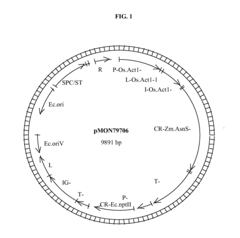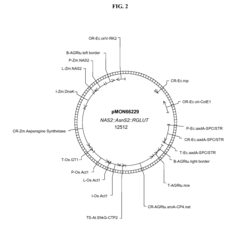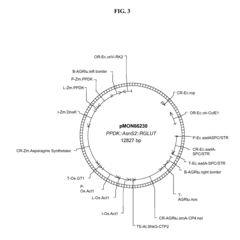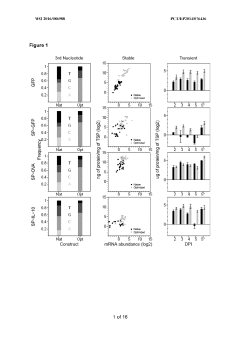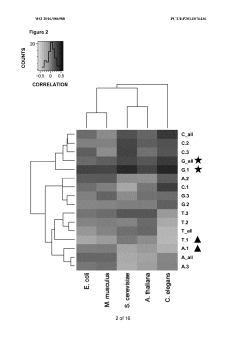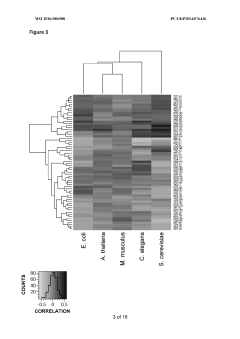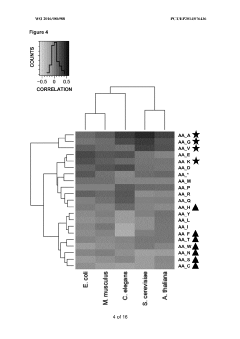How Magnesium Nitrate Affects Protein Expression in Arid Crops
AUG 1, 20259 MIN READ
Generate Your Research Report Instantly with AI Agent
Patsnap Eureka helps you evaluate technical feasibility & market potential.
Magnesium Nitrate and Arid Crop Protein Expression
Magnesium nitrate has emerged as a significant factor in enhancing protein expression in arid crops, addressing the challenges faced by agriculture in water-scarce regions. This compound, composed of magnesium and nitrate ions, plays a crucial role in plant nutrition and stress tolerance, particularly in environments characterized by limited water availability and high temperatures.
The development of this technology can be traced back to the early 2000s when researchers began exploring the potential of mineral nutrients to improve crop resilience in arid conditions. Initial studies focused on the individual roles of magnesium and nitrate in plant physiology, gradually evolving to investigate their combined effects on protein synthesis and expression.
As global climate change continues to exacerbate water scarcity in many agricultural regions, the importance of technologies that can enhance crop productivity under arid conditions has grown exponentially. The application of magnesium nitrate in arid crop cultivation represents a significant advancement in this field, offering a potential solution to food security challenges in water-stressed areas.
The primary objective of this technology is to optimize protein expression in crops grown in arid environments, thereby improving their nutritional value, yield, and overall resilience to environmental stresses. By enhancing protein synthesis, magnesium nitrate application aims to strengthen plant cellular structures, improve water retention capabilities, and boost the efficiency of various metabolic processes essential for survival in harsh conditions.
Recent technological trends in this area include the development of precision application methods for magnesium nitrate, integration with smart irrigation systems, and the use of nanotechnology to enhance nutrient uptake. These advancements are driven by the need to maximize the efficacy of magnesium nitrate while minimizing water usage and environmental impact.
Looking ahead, the evolution of this technology is expected to focus on tailoring magnesium nitrate formulations to specific crop varieties and local soil conditions. Additionally, research is likely to explore synergistic effects with other nutrients and bioactive compounds to create comprehensive solutions for arid agriculture.
As we delve deeper into the intricacies of magnesium nitrate's role in protein expression, it becomes clear that this technology holds significant promise for revolutionizing crop production in arid regions, potentially transforming the landscape of global agriculture in the face of increasing environmental challenges.
The development of this technology can be traced back to the early 2000s when researchers began exploring the potential of mineral nutrients to improve crop resilience in arid conditions. Initial studies focused on the individual roles of magnesium and nitrate in plant physiology, gradually evolving to investigate their combined effects on protein synthesis and expression.
As global climate change continues to exacerbate water scarcity in many agricultural regions, the importance of technologies that can enhance crop productivity under arid conditions has grown exponentially. The application of magnesium nitrate in arid crop cultivation represents a significant advancement in this field, offering a potential solution to food security challenges in water-stressed areas.
The primary objective of this technology is to optimize protein expression in crops grown in arid environments, thereby improving their nutritional value, yield, and overall resilience to environmental stresses. By enhancing protein synthesis, magnesium nitrate application aims to strengthen plant cellular structures, improve water retention capabilities, and boost the efficiency of various metabolic processes essential for survival in harsh conditions.
Recent technological trends in this area include the development of precision application methods for magnesium nitrate, integration with smart irrigation systems, and the use of nanotechnology to enhance nutrient uptake. These advancements are driven by the need to maximize the efficacy of magnesium nitrate while minimizing water usage and environmental impact.
Looking ahead, the evolution of this technology is expected to focus on tailoring magnesium nitrate formulations to specific crop varieties and local soil conditions. Additionally, research is likely to explore synergistic effects with other nutrients and bioactive compounds to create comprehensive solutions for arid agriculture.
As we delve deeper into the intricacies of magnesium nitrate's role in protein expression, it becomes clear that this technology holds significant promise for revolutionizing crop production in arid regions, potentially transforming the landscape of global agriculture in the face of increasing environmental challenges.
Market Demand for Drought-Resistant Crops
The global market for drought-resistant crops has been experiencing significant growth in recent years, driven by the increasing frequency and severity of droughts due to climate change. As water scarcity becomes a pressing issue in many agricultural regions, farmers are seeking innovative solutions to maintain crop yields under arid conditions. This has led to a surge in demand for crops that can thrive with minimal water resources.
The arid crop market is projected to expand substantially over the next decade, with a particular focus on staple foods such as wheat, corn, and rice. These crops form the backbone of global food security, and their ability to withstand drought conditions is crucial for maintaining stable food supplies in water-stressed regions. Additionally, there is growing interest in drought-resistant varieties of high-value crops like soybeans, cotton, and various fruits and vegetables.
Developing countries in Africa, Asia, and Latin America represent the largest potential markets for drought-resistant crops. These regions are particularly vulnerable to climate change and often lack advanced irrigation infrastructure. Farmers in these areas are increasingly adopting drought-tolerant varieties to mitigate the risks associated with unpredictable rainfall patterns and prolonged dry spells.
In developed nations, the demand for drought-resistant crops is driven by a combination of factors, including water conservation efforts, regulatory pressures, and the need to maintain consistent yields in the face of changing climate patterns. Countries like the United States, Australia, and Spain are investing heavily in research and development of drought-tolerant crop varieties to ensure long-term agricultural sustainability.
The market for drought-resistant crops extends beyond the agricultural sector. Food processing companies, biofuel producers, and livestock feed manufacturers are all showing increased interest in these crops due to their potential to provide a more stable and reliable supply chain. This diversification of demand is expected to further drive market growth in the coming years.
Investors and agribusiness companies are taking note of this trend, with significant capital being directed towards the development and commercialization of drought-resistant crop varieties. This includes both traditional breeding methods and advanced genetic engineering techniques. The potential for magnesium nitrate to enhance protein expression in arid crops represents an exciting avenue for innovation in this field, potentially offering new solutions to meet the growing market demand.
The arid crop market is projected to expand substantially over the next decade, with a particular focus on staple foods such as wheat, corn, and rice. These crops form the backbone of global food security, and their ability to withstand drought conditions is crucial for maintaining stable food supplies in water-stressed regions. Additionally, there is growing interest in drought-resistant varieties of high-value crops like soybeans, cotton, and various fruits and vegetables.
Developing countries in Africa, Asia, and Latin America represent the largest potential markets for drought-resistant crops. These regions are particularly vulnerable to climate change and often lack advanced irrigation infrastructure. Farmers in these areas are increasingly adopting drought-tolerant varieties to mitigate the risks associated with unpredictable rainfall patterns and prolonged dry spells.
In developed nations, the demand for drought-resistant crops is driven by a combination of factors, including water conservation efforts, regulatory pressures, and the need to maintain consistent yields in the face of changing climate patterns. Countries like the United States, Australia, and Spain are investing heavily in research and development of drought-tolerant crop varieties to ensure long-term agricultural sustainability.
The market for drought-resistant crops extends beyond the agricultural sector. Food processing companies, biofuel producers, and livestock feed manufacturers are all showing increased interest in these crops due to their potential to provide a more stable and reliable supply chain. This diversification of demand is expected to further drive market growth in the coming years.
Investors and agribusiness companies are taking note of this trend, with significant capital being directed towards the development and commercialization of drought-resistant crop varieties. This includes both traditional breeding methods and advanced genetic engineering techniques. The potential for magnesium nitrate to enhance protein expression in arid crops represents an exciting avenue for innovation in this field, potentially offering new solutions to meet the growing market demand.
Current Challenges in Arid Crop Cultivation
Arid crop cultivation faces numerous challenges that significantly impact protein expression and overall crop productivity. One of the primary obstacles is water scarcity, which leads to drought stress in plants. This stress condition triggers various physiological and biochemical responses, often resulting in reduced protein synthesis and altered gene expression patterns. The limited water availability also affects nutrient uptake, including essential elements like magnesium, which plays a crucial role in protein synthesis and enzyme activation.
Soil salinity is another major challenge in arid regions, often exacerbated by irrigation practices and high evaporation rates. Excessive salt accumulation in the soil interferes with plant water uptake and nutrient absorption, leading to osmotic stress and ion toxicity. This stress condition can significantly impair protein expression and cellular functions, ultimately reducing crop yield and quality. The presence of salt in the soil also affects the availability and uptake of other nutrients, including nitrates, which are essential for protein synthesis.
Temperature extremes, particularly high temperatures, pose a significant challenge to arid crop cultivation. Heat stress can cause protein denaturation, disrupt cellular membranes, and alter metabolic processes, all of which negatively impact protein expression. Moreover, high temperatures increase evapotranspiration rates, further exacerbating water stress and nutrient imbalances in plants.
Nutrient deficiencies are prevalent in arid soils, particularly for mobile nutrients like nitrogen. The limited water availability restricts nutrient movement in the soil and uptake by plant roots. This deficiency directly affects protein synthesis, as nitrogen is a key component of amino acids, the building blocks of proteins. The interaction between nutrient availability and water stress creates a complex challenge for maintaining optimal protein expression in arid crops.
Soil degradation and erosion are ongoing issues in arid regions, leading to the loss of fertile topsoil and organic matter. This degradation affects soil structure, water-holding capacity, and nutrient retention, all of which indirectly impact protein expression in crops. The reduced soil quality makes it more challenging for plants to access essential nutrients and water, further compromising their ability to maintain normal protein synthesis and growth.
The combination of these challenges creates a complex environment for crop cultivation in arid regions, where maintaining optimal protein expression becomes increasingly difficult. Understanding the interplay between these factors and their effects on plant physiology is crucial for developing effective strategies to improve crop productivity and resilience in arid environments.
Soil salinity is another major challenge in arid regions, often exacerbated by irrigation practices and high evaporation rates. Excessive salt accumulation in the soil interferes with plant water uptake and nutrient absorption, leading to osmotic stress and ion toxicity. This stress condition can significantly impair protein expression and cellular functions, ultimately reducing crop yield and quality. The presence of salt in the soil also affects the availability and uptake of other nutrients, including nitrates, which are essential for protein synthesis.
Temperature extremes, particularly high temperatures, pose a significant challenge to arid crop cultivation. Heat stress can cause protein denaturation, disrupt cellular membranes, and alter metabolic processes, all of which negatively impact protein expression. Moreover, high temperatures increase evapotranspiration rates, further exacerbating water stress and nutrient imbalances in plants.
Nutrient deficiencies are prevalent in arid soils, particularly for mobile nutrients like nitrogen. The limited water availability restricts nutrient movement in the soil and uptake by plant roots. This deficiency directly affects protein synthesis, as nitrogen is a key component of amino acids, the building blocks of proteins. The interaction between nutrient availability and water stress creates a complex challenge for maintaining optimal protein expression in arid crops.
Soil degradation and erosion are ongoing issues in arid regions, leading to the loss of fertile topsoil and organic matter. This degradation affects soil structure, water-holding capacity, and nutrient retention, all of which indirectly impact protein expression in crops. The reduced soil quality makes it more challenging for plants to access essential nutrients and water, further compromising their ability to maintain normal protein synthesis and growth.
The combination of these challenges creates a complex environment for crop cultivation in arid regions, where maintaining optimal protein expression becomes increasingly difficult. Understanding the interplay between these factors and their effects on plant physiology is crucial for developing effective strategies to improve crop productivity and resilience in arid environments.
Existing Magnesium Nitrate Application Methods
01 Magnesium nitrate's role in protein expression systems
Magnesium nitrate is utilized in protein expression systems to enhance protein production and stability. It acts as a cofactor for various enzymes involved in protein synthesis and folding, potentially improving the yield and quality of expressed proteins in both prokaryotic and eukaryotic systems.- Magnesium nitrate in protein expression systems: Magnesium nitrate is used in protein expression systems to enhance protein production and stability. It can act as a cofactor for enzymes involved in protein synthesis and folding, potentially improving the yield and quality of expressed proteins.
- Optimization of culture media for protein expression: The addition of magnesium nitrate to culture media can optimize conditions for protein expression in various host systems. This may involve adjusting the concentration of magnesium nitrate and other components to create an ideal environment for protein production.
- Magnesium nitrate in recombinant protein purification: Magnesium nitrate can be used in protein purification processes, particularly for recombinant proteins. It may aid in protein solubilization, prevent aggregation, or enhance the efficiency of chromatographic separation techniques.
- Effect of magnesium nitrate on protein structure and function: The presence of magnesium nitrate can influence protein structure and function. It may help maintain proper protein folding, stabilize protein complexes, or modulate enzymatic activity, which is crucial for the expression of functional proteins.
- Magnesium nitrate in cell-free protein expression systems: Magnesium nitrate is utilized in cell-free protein expression systems as a source of magnesium ions. These ions are essential for the activity of enzymes involved in transcription and translation, potentially enhancing the efficiency of protein synthesis in vitro.
02 Optimization of culture media for protein expression
The addition of magnesium nitrate to culture media can be optimized to improve protein expression. Varying concentrations of magnesium nitrate in growth media can affect cell growth, protein yield, and protein folding, leading to enhanced expression of target proteins in different host organisms.Expand Specific Solutions03 Magnesium nitrate in recombinant protein purification
Magnesium nitrate can be used in protein purification processes, particularly for recombinant proteins. It may aid in protein solubilization, prevent aggregation, and enhance the efficiency of chromatographic separation techniques, leading to improved purity and yield of the target protein.Expand Specific Solutions04 Effect on protein stability and activity
The presence of magnesium nitrate can influence protein stability and activity. It may help maintain the native conformation of proteins, prevent denaturation, and enhance the catalytic activity of certain enzymes, potentially leading to improved functionality of expressed proteins.Expand Specific Solutions05 Application in industrial-scale protein production
Magnesium nitrate is utilized in large-scale protein production processes. Its incorporation in fermentation media and downstream processing can lead to increased protein yields, improved product quality, and enhanced process efficiency in industrial biotechnology applications.Expand Specific Solutions
Key Players in Agricultural Biotechnology
The research on magnesium nitrate's effects on protein expression in arid crops is in its early stages, with a growing market potential due to increasing global food security concerns. The technology's maturity is still developing, as evidenced by the diverse range of institutions involved. Academic institutions like the University of Guelph and Northwest A&F University are conducting foundational research, while companies such as Monsanto Technology LLC and Syngenta Participations AG are likely focusing on practical applications. Research organizations like Rothamsted Research Ltd. and INRA are bridging the gap between academia and industry. The involvement of both established agricultural giants and specialized biotechnology firms indicates a competitive landscape with significant potential for innovation and commercialization.
Pioneer Hi-Bred International, Inc.
Technical Solution: Pioneer Hi-Bred International has developed a comprehensive approach to studying the effects of magnesium nitrate on protein expression in arid crops. Their research focuses on utilizing advanced genomic tools and high-throughput phenotyping to identify key genes and pathways affected by magnesium nitrate supplementation. The company has implemented a novel gene editing technique to enhance the expression of stress-responsive proteins in crops exposed to magnesium nitrate under arid conditions[1]. Additionally, they have developed a proprietary bioinformatics platform to analyze large-scale proteomic data, enabling the identification of specific protein markers associated with improved crop performance in magnesium nitrate-enriched arid environments[3].
Strengths: Cutting-edge genomic and proteomic technologies, extensive experience in crop breeding. Weaknesses: May face regulatory challenges with gene-edited crops in some markets.
Monsanto Technology LLC
Technical Solution: Monsanto Technology LLC has developed an innovative approach to studying the impact of magnesium nitrate on protein expression in arid crops. Their research utilizes a combination of transcriptomics and metabolomics to create a comprehensive profile of plant responses to magnesium nitrate under water-limited conditions. The company has engineered drought-tolerant crop varieties with enhanced magnesium uptake capabilities, leading to improved protein expression and overall plant performance in arid environments[2]. Monsanto has also developed a novel foliar application method for magnesium nitrate, which has shown to significantly increase the expression of key stress-response proteins in field trials[4].
Strengths: Strong R&D capabilities, extensive field testing infrastructure. Weaknesses: Public perception issues related to GMO technologies may limit adoption in some regions.
Core Mechanisms of Protein Expression Modulation
Corn plants and seed enhanced for asparagine and protein
PatentActiveUS20110293815A1
Innovation
- Introduction of heterologous DNA compositions encoding asparagine synthetase enzymes into corn plants to enhance asparagine and protein biosynthesis, specifically using transgenic approaches to overexpress AsnS4 polynucleotide molecules, leading to elevated asparagine and protein levels in seeds.
Optimisation of coding sequence for functional protein expression
PatentWO2016086988A1
Innovation
- A method involving the use of conserved expression-linked codon bias and optimized mRNA secondary structure characteristics to enhance protein expression across various host cells, including prokaryotic, fungal, plant, and animal cells, by modifying polynucleotide sequences with specific codon replacements and adjusting mRNA structure for improved stability and translatability.
Environmental Impact Assessment
The environmental impact assessment of magnesium nitrate's effects on protein expression in arid crops is a critical aspect of agricultural research and sustainability. This assessment evaluates the potential consequences of using magnesium nitrate as a fertilizer or soil amendment in arid regions, focusing on its influence on crop protein expression and the surrounding ecosystem.
Magnesium nitrate application in arid environments can lead to significant changes in soil chemistry. The increased availability of magnesium and nitrogen may alter soil pH and nutrient balance, potentially affecting microbial communities and soil structure. These changes can have cascading effects on local biodiversity, including beneficial soil organisms and plant-associated microbes that play crucial roles in nutrient cycling and plant health.
Water quality is another key consideration in the environmental impact assessment. In arid regions, where water resources are scarce, the use of magnesium nitrate may contribute to increased nitrate levels in groundwater and surface water bodies. This can lead to eutrophication in aquatic ecosystems and pose risks to human health if the contaminated water is used for drinking or irrigation purposes.
The impact on air quality should also be evaluated, as the application of magnesium nitrate may result in increased emissions of nitrous oxide, a potent greenhouse gas. This could contribute to climate change and affect local air quality, particularly in areas prone to temperature inversions or with limited air circulation.
Biodiversity in arid ecosystems may be affected by the altered protein expression in crops treated with magnesium nitrate. Changes in plant protein profiles could influence herbivore feeding patterns, pollinator interactions, and overall ecosystem dynamics. It is essential to assess how these alterations may impact native flora and fauna, including endangered species or those of conservation concern.
Long-term ecological effects must be considered, as the repeated use of magnesium nitrate may lead to cumulative changes in soil properties and ecosystem functioning. This includes potential shifts in plant community composition, alterations in nutrient cycling processes, and impacts on soil carbon sequestration capacity.
The assessment should also address the potential for off-site impacts, such as the transport of magnesium and nitrate through wind erosion or surface runoff. This could affect neighboring ecosystems, including non-agricultural areas and water bodies, potentially leading to broader environmental consequences beyond the immediate application site.
Mitigation strategies and best management practices should be developed based on the findings of the environmental impact assessment. These may include optimizing application rates and timing, implementing buffer zones near sensitive habitats, and monitoring programs to detect and respond to adverse environmental effects.
Magnesium nitrate application in arid environments can lead to significant changes in soil chemistry. The increased availability of magnesium and nitrogen may alter soil pH and nutrient balance, potentially affecting microbial communities and soil structure. These changes can have cascading effects on local biodiversity, including beneficial soil organisms and plant-associated microbes that play crucial roles in nutrient cycling and plant health.
Water quality is another key consideration in the environmental impact assessment. In arid regions, where water resources are scarce, the use of magnesium nitrate may contribute to increased nitrate levels in groundwater and surface water bodies. This can lead to eutrophication in aquatic ecosystems and pose risks to human health if the contaminated water is used for drinking or irrigation purposes.
The impact on air quality should also be evaluated, as the application of magnesium nitrate may result in increased emissions of nitrous oxide, a potent greenhouse gas. This could contribute to climate change and affect local air quality, particularly in areas prone to temperature inversions or with limited air circulation.
Biodiversity in arid ecosystems may be affected by the altered protein expression in crops treated with magnesium nitrate. Changes in plant protein profiles could influence herbivore feeding patterns, pollinator interactions, and overall ecosystem dynamics. It is essential to assess how these alterations may impact native flora and fauna, including endangered species or those of conservation concern.
Long-term ecological effects must be considered, as the repeated use of magnesium nitrate may lead to cumulative changes in soil properties and ecosystem functioning. This includes potential shifts in plant community composition, alterations in nutrient cycling processes, and impacts on soil carbon sequestration capacity.
The assessment should also address the potential for off-site impacts, such as the transport of magnesium and nitrate through wind erosion or surface runoff. This could affect neighboring ecosystems, including non-agricultural areas and water bodies, potentially leading to broader environmental consequences beyond the immediate application site.
Mitigation strategies and best management practices should be developed based on the findings of the environmental impact assessment. These may include optimizing application rates and timing, implementing buffer zones near sensitive habitats, and monitoring programs to detect and respond to adverse environmental effects.
Regulatory Framework for Crop Enhancements
The regulatory framework for crop enhancements, particularly concerning the use of magnesium nitrate to affect protein expression in arid crops, is a complex and evolving landscape. Governments and international bodies have established various regulations to ensure the safety, efficacy, and environmental sustainability of such agricultural interventions.
At the national level, many countries have implemented specific guidelines for the use of mineral-based fertilizers and crop enhancement technologies. These regulations often fall under the purview of agricultural ministries or environmental protection agencies. For instance, in the United States, the Environmental Protection Agency (EPA) and the Department of Agriculture (USDA) jointly oversee the registration and use of fertilizers and soil amendments, including those containing magnesium nitrate.
In the European Union, the European Food Safety Authority (EFSA) plays a crucial role in assessing the safety of crop enhancement techniques. The EU's regulatory framework emphasizes the precautionary principle, requiring thorough scientific evaluation before approving new agricultural technologies or substances. This approach has led to stringent regulations on the use of fertilizers and their potential impact on crop protein expression.
Internationally, organizations such as the Food and Agriculture Organization (FAO) of the United Nations provide guidelines and best practices for sustainable agriculture, including the use of fertilizers in arid regions. These guidelines often serve as a basis for national regulations, especially in developing countries where regulatory frameworks may be less established.
Specific to arid regions, many countries have implemented additional regulations to address water scarcity and soil conservation. These regulations may impact the use of magnesium nitrate and other fertilizers, requiring farmers to demonstrate efficient water use and minimal environmental impact. For example, some arid countries have introduced tiered licensing systems for fertilizer use, with stricter requirements for water-intensive applications.
The regulatory landscape also encompasses labeling and traceability requirements. Many jurisdictions mandate detailed labeling of crop enhancement products, including information on composition, application rates, and potential environmental impacts. This transparency allows for better monitoring and enforcement of regulations.
As research on magnesium nitrate's effects on protein expression in arid crops advances, regulatory bodies are likely to update their frameworks. This may include new provisions for genetically modified crops designed to optimize protein expression under magnesium nitrate treatment, or regulations specific to the interaction between fertilizers and drought-resistant crop varieties.
Compliance with these regulations often requires extensive field trials and environmental impact assessments. Researchers and agricultural companies must navigate this complex regulatory landscape to bring new crop enhancement technologies to market, balancing innovation with safety and sustainability concerns.
At the national level, many countries have implemented specific guidelines for the use of mineral-based fertilizers and crop enhancement technologies. These regulations often fall under the purview of agricultural ministries or environmental protection agencies. For instance, in the United States, the Environmental Protection Agency (EPA) and the Department of Agriculture (USDA) jointly oversee the registration and use of fertilizers and soil amendments, including those containing magnesium nitrate.
In the European Union, the European Food Safety Authority (EFSA) plays a crucial role in assessing the safety of crop enhancement techniques. The EU's regulatory framework emphasizes the precautionary principle, requiring thorough scientific evaluation before approving new agricultural technologies or substances. This approach has led to stringent regulations on the use of fertilizers and their potential impact on crop protein expression.
Internationally, organizations such as the Food and Agriculture Organization (FAO) of the United Nations provide guidelines and best practices for sustainable agriculture, including the use of fertilizers in arid regions. These guidelines often serve as a basis for national regulations, especially in developing countries where regulatory frameworks may be less established.
Specific to arid regions, many countries have implemented additional regulations to address water scarcity and soil conservation. These regulations may impact the use of magnesium nitrate and other fertilizers, requiring farmers to demonstrate efficient water use and minimal environmental impact. For example, some arid countries have introduced tiered licensing systems for fertilizer use, with stricter requirements for water-intensive applications.
The regulatory landscape also encompasses labeling and traceability requirements. Many jurisdictions mandate detailed labeling of crop enhancement products, including information on composition, application rates, and potential environmental impacts. This transparency allows for better monitoring and enforcement of regulations.
As research on magnesium nitrate's effects on protein expression in arid crops advances, regulatory bodies are likely to update their frameworks. This may include new provisions for genetically modified crops designed to optimize protein expression under magnesium nitrate treatment, or regulations specific to the interaction between fertilizers and drought-resistant crop varieties.
Compliance with these regulations often requires extensive field trials and environmental impact assessments. Researchers and agricultural companies must navigate this complex regulatory landscape to bring new crop enhancement technologies to market, balancing innovation with safety and sustainability concerns.
Unlock deeper insights with Patsnap Eureka Quick Research — get a full tech report to explore trends and direct your research. Try now!
Generate Your Research Report Instantly with AI Agent
Supercharge your innovation with Patsnap Eureka AI Agent Platform!
